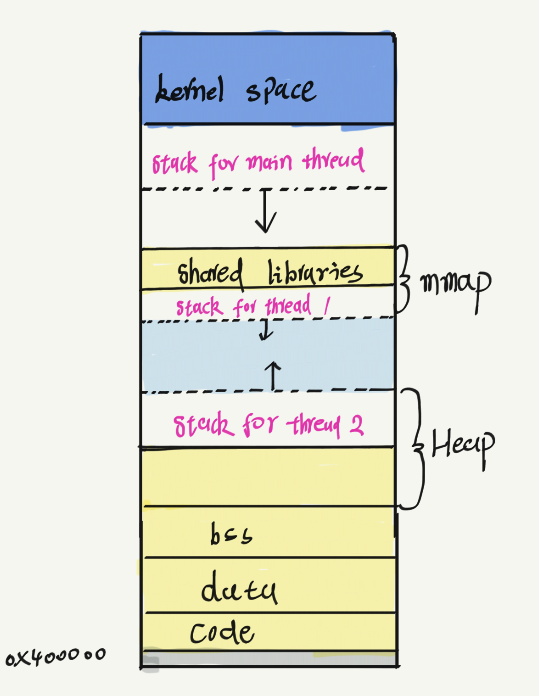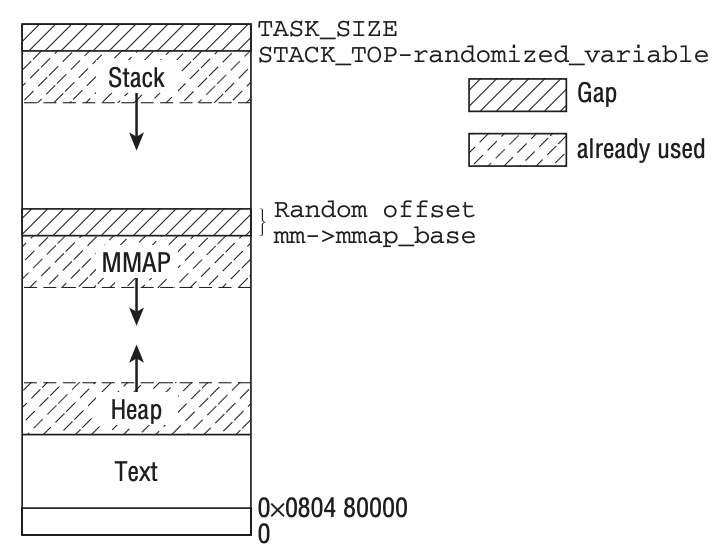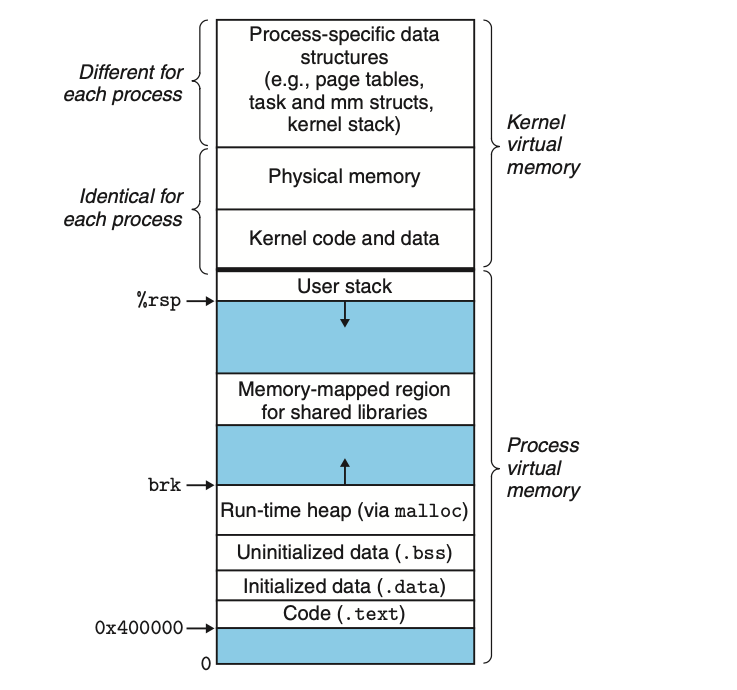通过 从CPU的视角说起 和 穿越虚拟内存的迷雾 两篇文章我们知道,所谓进程堆栈不过是应用程序向内核申请了一块连续内存后,设定相应的寄存器,从而将这块内存当做堆栈来使用,典型的用法就是用于函数调用。
我们在上一篇讨论了进线程的堆栈,现在继续探索 go 中的协程栈。如果吊一下书袋的话,口称 go 协程是不严谨的,go 的协程不同于其他语言的协程,go 的协程是一种有栈协程,每一个协程都有自己的协程堆栈,因此 go 官网发明了一个新词 goroutine,以区别于普通的 coroutine。我们接下来就聊聊 goroutine 的堆栈。在此之前,先来回顾一下上一篇中对进线程堆栈位置的总结。
本文基于 Linux 平台 x64 架构,使用 go 1.18 源码,禁用 cgo
1· 进线程堆栈

图 3-1 位于不同区域的线程 stack
图 3.1 为 64 位虚拟地址空间布局图,粉色标识说明了线程堆栈可能存在的位置,总结下来,不外乎以下三种情况:
主线程堆栈位于用户空间顶部,但 clone 时,子进程的主线程实际使用的堆栈未必如此。
有可能分配在 mmap 区域。
有可能通过 C 库 malloc 分配在 heap 区域。
2. goroutine 的堆栈
或许你已经知道 goroutine 的堆栈是从 heap 上分配的,但如果你足够好奇,你就会为 heap 在虚拟地址空间中的位置而发狂。
go 重写了运行时,如果不使用 cgo 的话,编译完成的 go 程序是静态链接的,不依赖任何 C 库,这使它拥有不错的可移植性,在较新内核上编译好的程序,拉到旧版本内核的操作系统上依然能够运行。在这一点上,rust 并没有多少优势,反而新生语言 hare 表现足够强劲。
不依赖 C 库,意味着 go 对 heap 的管理有自己的方式。 那么, go 管理的 heap 是否与之前内存空间布局图中的 heap 位置相同就要打一个大大的问号了。要搞清楚这个问题,我们需要到 runtime 的源码中一探究竟,且要挖到 go 与内核的接口处,找出其申请内存的方式方可。
本文并不打算分析 go 的内存分配器,也不打算介绍堆栈的分配算法,仅仅为了解决 goroutine 堆栈在虚拟地址空间中位置的疑惑。想了解内存管理和堆栈分配算法的读者可以参考详解Go中内存分配源码实现与一文教你搞懂 Go 中栈操作。
先从普通 goroutine 的创建开始吧!
在 go 中,每通过go func(){}的方式开启一个 goroutine 时,编译器都会将其转换成对 runtime.newproc的调用:
// Create a new g running fn.// Put it on the queue of g's waiting to run.// The compiler turns a go statement into a call to this.func newproc(fn *funcval) { gp := getg() pc := getcallerpc() // 切换到线程堆栈创建 g systemstack(func() { newg := newproc1(fn, gp, pc)
_p_ := getg().m.p.ptr() runqput(_p_, newg, true)
if mainStarted { wakep() } })}
复制代码
newproc 仅仅是对 newproc1 的包装,创建新 g 的动作不能在用户堆栈上进行,所以这里切换到底层线程的堆栈来执行。
// Create a new g in state _Grunnable, starting at fn. callerpc is the// address of the go statement that created this. The caller is responsible// for adding the new g to the scheduler.func newproc1(fn *funcval, callergp *g, callerpc uintptr) *g { _g_ := getg()
if fn == nil { _g_.m.throwing = -1 // do not dump full stacks throw("go of nil func value") } acquirem() // disable preemption because it can be holding p in a local var
_p_ := _g_.m.p.ptr() // 从 P 的空闲链表中获取一个新的 G newg := gfget(_p_) // 获取不到则调用 malg 进行创建 if newg == nil { newg = malg(_StackMin) casgstatus(newg, _Gidle, _Gdead) allgadd(newg) // publishes with a g->status of Gdead so GC scanner doesn't look at uninitialized stack. } ......}
复制代码
newproc1 方法很长,里面主要是获取 G ,然后对获取到的 G 做一些初始化的工作。当创建 G 时,会先从缓存的空闲链表中获取,如果没有空闲的 G ,再进行创建。所以,我们这里只看 malg 函数的调用。
在调用 malg 函数的时候会传入一个最小堆栈大小值:_StackMin(linux 平台下为 2048)。
// Allocate a new g, with a stack big enough for stacksize bytes.func malg(stacksize int32) *g { newg := new(g) if stacksize >= 0 { stacksize = round2(_StackSystem + stacksize) systemstack(func() { newg.stack = stackalloc(uint32(stacksize)) }) newg.stackguard0 = newg.stack.lo + _StackGuard newg.stackguard1 = ^uintptr(0) // Clear the bottom word of the stack. We record g // there on gsignal stack during VDSO on ARM and ARM64. *(*uintptr)(unsafe.Pointer(newg.stack.lo)) = 0 } return newg}
复制代码
malg 会创建新的 G 并为其设置好堆栈,以及堆栈的边界,以供日后扩容使用。这里重点看 stackalloc 函数,堆栈的内存的分配就是由它来完成的,函数的返回值赋给新 G 的 stack 字段。
G 的 stack 字段是一个 stack 结构体类型,里面标记了堆栈的高地址和低地址:
// Stack describes a Go execution stack.// The bounds of the stack are exactly [lo, hi),// with no implicit data structures on either side.type stack struct { lo uintptr hi uintptr}
复制代码
我们接着看这个 stack 是怎么创建出来的。
stackalloc 的函数比较长,里面涉及到大堆栈和小堆栈的分配逻辑,这里就不贴大段的代码了。这个函数不管是从 cache 还是 pool 中获取内存,最终都会在内存不够时调用 mheap 的allocManual函数去分配新的内存:
mheap_.allocManual(_StackCacheSize>>_PageShift, spanAllocStack)
复制代码
到这里就遇见 go 管理的 heap 了,关于 heap 的位置我们稍后再讨论,现在继续挖 allocManual 直到我们找到系统调用为止。
func (h *mheap) allocManual(npages uintptr, typ spanAllocType) *mspan { if !typ.manual() { throw("manual span allocation called with non-manually-managed type") } return h.allocSpan(npages, typ, 0)}
复制代码
allocManual 只是对 allocSpan 的简单封装,这里简单提一下 go 对内存管理的最小单位是 mspan,它包含若干连续的页。
allocSpan 的逻辑较多,主要是从 heap 中分配 npages 个页来填充 span。一般随着程序的运行,内存的不断申请,heap 中会有很多空闲的页用来供给后续的内存申请。现在我们需要查看 cache 不足的情况,当 heap 中的 page 不够的时候,就需要推动 heap 增长了,allocSpan 通过调用 mheap.grow 来达成这一点。
// Try to add at least npage pages of memory to the heap,// returning how much the heap grew by and whether it worked.func (h *mheap) grow(npage uintptr) (uintptr, bool) { assertLockHeld(&h.lock) ask := alignUp(npage, pallocChunkPages) * pageSize totalGrowth := uintptr(0) // This may overflow because ask could be very large // and is otherwise unrelated to h.curArena.base. // curArena 无需初始化,但问题是怎么判断 Arena 边界呢 end := h.curArena.base + ask nBase := alignUp(end, physPageSize) if nBase > h.curArena.end || /* overflow */ end < h.curArena.base { // 尝试分配新的 Arena,但有可能跨越 hint 区域,所以全额申请 // Not enough room in the current arena. Allocate more // arena space. This may not be contiguous with the // current arena, so we have to request the full ask. av, asize := h.sysAlloc(ask) // 此时已经将需要的内存 reserve 了 if av == nil { print("runtime: out of memory: cannot allocate ", ask, "-byte block (", memstats.heap_sys, " in use)\n") return 0, false }
if uintptr(av) == h.curArena.end { // 说明是连续的,拓展此 curArena 的边界 // The new space is contiguous with the old // space, so just extend the current space. h.curArena.end = uintptr(av) + asize } else { // 感觉像是这一次不够分配的,但也别浪费,把剩余的内存标记为已使用,加入到一个地方以供分配 // The new space is discontiguous. Track what // remains of the current space and switch to // the new space. This should be rare. if size := h.curArena.end - h.curArena.base; size != 0 { // Transition this space from Reserved to Prepared and mark it // as released since we'll be able to start using it after updating // the page allocator and releasing the lock at any time. sysMap(unsafe.Pointer(h.curArena.base), size, &memstats.heap_sys) // Update stats. atomic.Xadd64(&memstats.heap_released, int64(size)) stats := memstats.heapStats.acquire() atomic.Xaddint64(&stats.releagrowsed, int64(size)) memstats.heapStats.release() // Update the page allocator's structures to make this // space ready for allocation. h.pages.grow(h.curArena.base, size) totalGrowth += size } // Switch to the new space. // 把 curArena 切换到新的地址 h.curArena.base = uintptr(av) h.curArena.end = uintptr(av) + asize }
// Recalculate nBase. // We know this won't overflow, because sysAlloc returned // a valid region starting at h.curArena.base which is at // least ask bytes in size. nBase = alignUp(h.curArena.base+ask, physPageSize) }
// 更新 base // Grow into the current arena. v := h.curArena.base h.curArena.base = nBase
// 把分配的那块内存标记为 Prepared // Transition the space we're going to use from Reserved to Prepared. sysMap(unsafe.Pointer(v), nBase-v, &memstats.heap_sys)
// ...... 省略部分代码
// Update the page allocator's structures to make this // space ready for allocation. h.pages.grow(v, nBase-v) totalGrowth += nBase - v return totalGrowth, true}
复制代码
当curArena的空闲内存(内核返回的内存空间往往会比请求的多一些)不足以满足分配时,调用mheap.sysAlloc来申请更多的空间。
func (h *mheap) sysAlloc(n uintptr) (v unsafe.Pointer, size uintptr) { assertLockHeld(&h.lock)
n = alignUp(n, heapArenaBytes)
// First, try the arena pre-reservation. v = h.arena.alloc(n, heapArenaBytes, &memstats.heap_sys) if v != nil { size = n goto mapped }
// Try to grow the heap at a hint address. for h.arenaHints != nil { hint := h.arenaHints p := hint.addr if hint.down { p -= n } if p+n < p { // We can't use this, so don't ask. v = nil } else if arenaIndex(p+n-1) >= 1<<arenaBits { // Outside addressable heap. Can't use. v = nil } else { v = sysReserve(unsafe.Pointer(p), n) } // 如果不相等,则说明 mmap 在建议的地址上没能分配成功 if p == uintptr(v) { // Success. Update the hint. if !hint.down { p += n } // 成功后,hint 的地址也跟着更新 hint.addr = p size = n break } // 此时,丢弃这次分配的内存,尝试下一个 arenaHints, 也就是下一个 1T 区间 // Failed. Discard this hint and try the next. // // TODO: This would be cleaner if sysReserve could be // told to only return the requested address. In // particular, this is already how Windows behaves, so // it would simplify things there. if v != nil { sysFree(v, n, nil) } h.arenaHints = hint.next h.arenaHintAlloc.free(unsafe.Pointer(hint)) }
if size == 0 { if raceenabled { // The race detector assumes the heap lives in // [0x00c000000000, 0x00e000000000), but we // just ran out of hints in this region. Give // a nice failure. throw("too many address space collisions for -race mode") }
// All of the hints failed, so we'll take any // (sufficiently aligned) address the kernel will give // us. // 所有的 hint 都失败了,然后让内核自动分配一个定量内存 v, size = sysReserveAligned(nil, n, heapArenaBytes) if v == nil { return nil, 0 }
// Create new hints for extending this region. hint := (*arenaHint)(h.arenaHintAlloc.alloc()) hint.addr, hint.down = uintptr(v), true hint.next, mheap_.arenaHints = mheap_.arenaHints, hint hint = (*arenaHint)(h.arenaHintAlloc.alloc()) hint.addr = uintptr(v) + size hint.next, mheap_.arenaHints = mheap_.arenaHints, hint } // ......省略大段代码 return}
复制代码
这里真正申请内存的操作是 sysReserve,让我们来一睹究竟:
func sysReserve(v unsafe.Pointer, n uintptr) unsafe.Pointer { p, err := mmap(v, n, _PROT_NONE, _MAP_ANON|_MAP_PRIVATE, -1, 0) if err != 0 { return nil } return p}
复制代码
熟悉的 mmap 映入眼帘!我们已经抵达了内核的大门,查看其定义发现,它包裹了一个sysMmap函数,该函数就是发起mmap系统调用的所在,它是由汇编语言写成,Linux 下函数体位于 sys_linux_amd64.s 中:
// sysMmap calls the mmap system call. It is implemented in assembly.func sysMmap(addr unsafe.Pointer, n uintptr, prot, flags, fd int32, off uint32) (p unsafe.Pointer, err int)
复制代码
mmap调用中的 flag _PROT_NONE, _MAP_ANON|_MAP_PRIVATE表示申请的内存块是无文件背景的匿名映射,这里在调用时传入了一个提示地址,用于告知内核尽量从要求的地址开始分配。
内核当然不能保证这一点,但 go 也足够倔强,如果不能保证连续增长,就另找一段空间开始:
// 如果不相等,则说明 mmap 在建议的地址上没能分配成功if p == uintptr(v) { // Success. Update the hint. if !hint.down { p += n } // 成功后,hint 的地址也跟着更新 hint.addr = p size = n break}// 此时,丢弃这次分配的内存,尝试下一个 arenaHints, 也就是下一个 1T 区间// Failed. Discard this hint and try the next.//// TODO: This would be cleaner if sysReserve could be// told to only return the requested address. In// particular, this is already how Windows behaves, so// it would simplify things there.if v != nil { sysFree(v, n, nil)}h.arenaHints = hint.nexth.arenaHintAlloc.free(unsafe.Pointer(hint))
复制代码
从 sysAlloc 返回之后,就意味着已经从内核申请到了一块空间。回到 mheap.grow的代码,会看到调用了 sysMap 再次向内核申请内存,sysMap 代码如下:
func sysMap(v unsafe.Pointer, n uintptr, sysStat *sysMemStat) { sysStat.add(int64(n))
p, err := mmap(v, n, _PROT_READ|_PROT_WRITE, _MAP_ANON|_MAP_FIXED|_MAP_PRIVATE, -1, 0) if err == _ENOMEM { throw("runtime: out of memory") } if p != v || err != 0 { print("runtime: mmap(", v, ", ", n, ") returned ", p, ", ", err, "\n") throw("runtime: cannot map pages in arena address space") }}
复制代码
可见,也是一个mmap系统调用,但传入的 flag 不同,多了一个 _MAP_FIXED 。
查看 mmap 的手册便会明白,在不提供_MAP_FIXED 的情况下,内核会尽量从给出的地址分配空间,但避免冲突是第一位的,所以结果并不总能如意。而_MAP_FIXED保证了这一点,即使在请求的地址处已有其它映射的情况下也会覆盖之前的映射。
mmap 文档中也对 _MAP_FIXED 使用提出了警示,而 go 在这里使用是完全没有问题的,因为事先已经向内核申请了该块内存了,在里面隔上一刀根本不需要睁眼。
我们拿到了一块连续的内存,是时候从 allocSpan 返回了,如此 stackalloc 就为新 G 申请到了一块连续内存用作堆栈。
从 goroutine 的新建一直到内核的大门,我们发现了用于申请内存的方式是 mmap,但mmap从进程虚拟地址空间的哪个位置分配内存呢?runtime 源码中给与的提示地址又是从何而来呢?
3. mmap 申请内存的位置
mmap 既是一个系统调用,也是进程虚拟地址空间中的一个区域,让我再次援引《深入 Linux 内核架构》中的一幅图:

图3-2 mmap 区域自顶向下扩展
书中介绍了 2.6 版本的内核内存布局,其中 mmap 区域是和 heap 相对增长的,内核会留出足够的空间给主线程 stack,这样便可最大化的利用内存空间,好在 stack 通常不会很大。
但是 mmap 并非只能在概念上划出的区域进行分配,它甚至可以在用户空间内任意地方分配内存,这当然也包括传统的 heap 区域!还记得 _MAP_FIXED 吧?我打赌它绝对能让你的程序 crash 掉!
heap 是用来为进程动态分配内存的,传统的定义是:堆是一段长度可变的连续虚拟内存,始于进程的未初始化数据段的末尾,随着内存的分配和释放而增减:

图 3-3 Linux 进程的虚拟内存布局
改变 heap 大小的系统调用是 brk 和 sbrk ,而 go 主要使用 mmap 来维护堆,这就说明 go 堆和传统的堆位置是不同的。位置虽然不同,但使命毫无二致,让我们来看一个 go 程序的内存布局:
00400000-004bd000 r-xp 00000000 103:02 8916313 playground/helloworld/hello/hello004bd000-00574000 r--p 000bd000 103:02 8916313 playground/helloworld/hello/hello00574000-0058f000 rw-p 00174000 103:02 8916313 playground/helloworld/hello/hello0058f000-005c4000 rw-p 00000000 00:00 0 c000000000-c000200000 rw-p 00000000 00:00 0c000200000-c017e00000 rw-p 00000000 00:00 0 c017e00000-c018000000 rw-p 00000000 00:00 0 c018000000-c018400000 rw-p 00000000 00:00 0 c018400000-c01c000000 ---p 00000000 00:00 0 7fef44906000-7fef449ba000 rw-p 00000000 00:00 0 7fef449d2000-7fef47c19000 rw-p 00000000 00:00 0 7fef47c19000-7fef57d99000 ---p 00000000 00:00 0 7fef57d99000-7fef57d9a000 rw-p 00000000 00:00 0 7fef57d9a000-7fef69c49000 ---p 00000000 00:00 0 7fef69c49000-7fef69c4a000 rw-p 00000000 00:00 0 7fef69c4a000-7fef6c01f000 ---p 00000000 00:00 0 7fef6c01f000-7fef6c020000 rw-p 00000000 00:00 0 7fef6c020000-7fef6c499000 ---p 00000000 00:00 0 7fef6c499000-7fef6c49a000 rw-p 00000000 00:00 0 7fef6c49a000-7fef6c519000 ---p 00000000 00:00 0 7fef6c519000-7fef6c579000 rw-p 00000000 00:00 0 7ffc335d5000-7ffc335f7000 rw-p 00000000 00:00 0 [stack]7ffc335f8000-7ffc335fc000 r--p 00000000 00:00 0 [vvar]7ffc335fc000-7ffc335fe000 r-xp 00000000 00:00 0 [vdso]ffffffffff600000-ffffffffff601000 --xp 00000000 00:00 0 [vsyscall]
复制代码
表 3-1 Go 进程的内存布局映射
除了代码段不足 2M 的区域之外,似乎 c000000000 最值得怀疑,而且这份映射当中没有看到 heap 身影,这直接印证了上述猜想。关于 c000000000 我们要去源码中寻找答案,且看内存分配器的初始化:
func mallocinit() { // ...... 省略部分代码
// 只看 64 位系统的初始化部分 // Create initial arena growth hints. if goarch.PtrSize == 8 { // On a 64-bit machine, we pick the following hints // because: // // 1. Starting from the middle of the address space // makes it easier to grow out a contiguous range // without running in to some other mapping. // // 2. This makes Go heap addresses more easily // recognizable when debugging. // // 3. Stack scanning in gccgo is still conservative, // so it's important that addresses be distinguishable // from other data. // // Starting at 0x00c0 means that the valid memory addresses // will begin 0x00c0, 0x00c1, ... // In little-endian, that's c0 00, c1 00, ... None of those are valid // UTF-8 sequences, and they are otherwise as far away from // ff (likely a common byte) as possible. If that fails, we try other 0xXXc0 // addresses. An earlier attempt to use 0x11f8 caused out of memory errors // on OS X during thread allocations. 0x00c0 causes conflicts with // AddressSanitizer which reserves all memory up to 0x0100. // These choices reduce the odds of a conservative garbage collector // not collecting memory because some non-pointer block of memory // had a bit pattern that matched a memory address. // // However, on arm64, we ignore all this advice above and slam the // allocation at 0x40 << 32 because when using 4k pages with 3-level // translation buffers, the user address space is limited to 39 bits // On ios/arm64, the address space is even smaller. // // On AIX, mmaps starts at 0x0A00000000000000 for 64-bit. // processes. for i := 0x7f; i >= 0; i-- { var p uintptr switch { case raceenabled: // The TSAN runtime requires the heap // to be in the range [0x00c000000000, // 0x00e000000000). p = uintptr(i)<<32 | uintptrMask&(0x00c0<<32) if p >= uintptrMask&0x00e000000000 { continue } case GOARCH == "arm64" && GOOS == "ios": p = uintptr(i)<<40 | uintptrMask&(0x0013<<28) case GOARCH == "arm64": p = uintptr(i)<<40 | uintptrMask&(0x0040<<32) case GOOS == "aix": if i == 0 { // We don't use addresses directly after 0x0A00000000000000 // to avoid collisions with others mmaps done by non-go programs. continue } p = uintptr(i)<<40 | uintptrMask&(0xa0<<52) default: p = uintptr(i)<<40 | uintptrMask&(0x00c0<<32) } hint := (*arenaHint)(mheap_.arenaHintAlloc.alloc()) hint.addr = p hint.next, mheap_.arenaHints = mheap_.arenaHints, hint } }}
复制代码
注释部分第一条便说:从地址空间的中间开始向上增长,很容易获得连续的区域,且不会和其它映射部位发生碰撞。
因此 go 选择了从 0x00c0开始,并且用一个 for 循环生成了 128 个提示地址,组成链表初始化到 mheap_.arenaHints:
0x7fc000000000......0x10c0000000000x0fc0000000000x0ec0000000000x0dc0000000000x0cc0000000000x0bc0000000000x0ac0000000000x09c0000000000x08c0000000000x07c0000000000x06c0000000000x05c0000000000x04c0000000000x03c0000000000x02c0000000000x01c0000000000x00c000000000
复制代码
这 128 个起始地址除了最后一个之外,其余皆可向上增长 1TiB 的空间,最后一个距离用户空间顶部仅剩 256 GiB。
0x00c000000000 距离用户空间的开始有 765 GiB,这也是为什么不会和其它映射部位发生碰撞的原因!
mallocinit 初始化了mheap_.arenaHints,还记得 mheap 为增加 heap 而申请内存时的方法吗?
// Try to grow the heap at a hint address.for h.arenaHints != nil { hint := h.arenaHints p := hint.addr if hint.down { p -= n } if p+n < p { // We can't use this, so don't ask. v = nil } else if arenaIndex(p+n-1) >= 1<<arenaBits { // Outside addressable heap. Can't use. v = nil } else { v = sysReserve(unsafe.Pointer(p), n) } // 如果不相等,则说明 mmap 在建议的地址上没能分配成功 if p == uintptr(v) { // Success. Update the hint. if !hint.down { p += n } // 成功后,hint 的地址也跟着更新 hint.addr = p size = n break } // 此时,丢弃这次分配的内存,尝试下一个 arenaHints, 也就是下一个 1T 区间 // Failed. Discard this hint and try the next. // // TODO: This would be cleaner if sysReserve could be // told to only return the requested address. In // particular, this is already how Windows behaves, so // it would simplify things there. if v != nil { sysFree(v, n, nil) } h.arenaHints = hint.next h.arenaHintAlloc.free(unsafe.Pointer(hint))}
复制代码
mmap 的调用都是围绕着 arenaHints 来进行的,并且每次申请成功后都会更新 hint 的 addr,这样就实现了连续增长,直到失败。如果失败了,就从下一个 1TiB 的区间再次开始!
4. g0 堆栈
看过了普通 goroutine 堆栈的分配之后,再来简要说一下 g0 的堆栈。g0 是个比较特殊的 goroutine 它只是协助 runtime 来执行,但不承载任何执行函数,与普通的用户 goroutine 有所区别。在一定程度上,可以把它类比成操作系统上每个线程的内核栈,每当 runtime 获得控制权的时候就会将堆栈切换到 g0 代表的堆栈上。
go 的 GPM 模型此处不作介绍,建议阅读Scheduling In Go : Part II - Go Scheduler 来了解并发模型。我们只说其中的 M,每个M 都有一个 g0 堆栈,用于执行 runtime 代码,其中较为特殊的 M0 (即 go 进程的主线程,每个 go 程序仅有一个 M0)的 g0 堆栈是通过汇编语言进行初始化的。
我们先来看看 go 程序的入口地址:
richard@Richard-Manjaro:~ » readelf -h carefree ELF Header: Magic: 7f 45 4c 46 02 01 01 00 00 00 00 00 00 00 00 00 Class: ELF64 Data: 2's complement, little endian Version: 1 (current) OS/ABI: UNIX - System V ABI Version: 0 Type: EXEC (Executable file) Machine: Advanced Micro Devices X86-64 Version: 0x1 <span style="color:red">Entry point address: 0x463f20</span> Start of program headers: 64 (bytes into file) Start of section headers: 456 (bytes into file) Flags: 0x0 Size of this header: 64 (bytes) Size of program headers: 56 (bytes) Number of program headers: 7 Size of section headers: 64 (bytes) Number of section headers: 23 Section header string table index: 3
复制代码
读取 ELF 文件头可知,入口地址为 0x463f20,因为禁用了 cgo,没有动态链接库,所以 Entry point 指示的地址既是程序的入口地址。继续看一下该地址指示的代码:
richard@Richard-Manjaro:~ » lldb ./carefree (lldb) target create "./carefree"Current executable set to '/home/richard/carefree' (x86_64).(lldb) image lookup --address 0x463f20 Address: carefree[0x0000000000463f20] (carefree.PT_LOAD[0]..text + 405280) Summary: carefree`_rt0_amd64_linux`(lldb)
复制代码
_rt0_amd64_linux 即为程序的入口,当运行程序时,shell 会 fork 一个子进程出来,之后执行 execve() 系统调用来装载 go 的可执行文件,当内核装载完毕之后,会将 CPU 的程序计数器设置为此入口点,之后 go 程序开始执行。
_rt0_amd64_linux 是对 asm_amd64.s 中 runtime·rt0_go 的调用,看一下runtime·rt0_go 的内容:
TEXT runtime·rt0_go(SB),NOSPLIT|TOPFRAME,$0 // copy arguments forward on an even stack MOVQ DI, AX // argc MOVQ SI, BX // argv SUBQ $(5*8), SP // 3args 2auto ANDQ $~15, SP MOVQ AX, 24(SP) MOVQ BX, 32(SP)
// create istack out of the given (operating system) stack. // _cgo_init may update stackguard. // 初始化 g0 MOVQ $runtime·g0(SB), DI LEAQ (-64*1024+104)(SP), BX MOVQ BX, g_stackguard0(DI) MOVQ BX, g_stackguard1(DI) MOVQ BX, (g_stack+stack_lo)(DI) MOVQ SP, (g_stack+stack_hi)(DI)
复制代码
这段代码设置 g0 堆栈的方式是使用线程堆栈的栈顶指针减少 64KB + 104B 作为 g0 堆栈的低端,当前线程堆栈的栈顶为 g0 堆栈的高端。执行完成后,g0 的堆栈便被初始化为 64KB 了。令人惊讶的是,这居然是在系统线程的 8M 堆栈(Linux 的默认线程堆栈为 8 M)中分配的。
再来看一下其它新建 M 的 g0,go 通过 runtime.newm 来新建操作系统线程,顺藤摸瓜会发现其最终执行的系统调用为 clone:
func newosproc(mp *m) { stk := unsafe.Pointer(mp.g0.stack.hi) /* * note: strace gets confused if we use CLONE_PTRACE here. */ if false { print("newosproc stk=", stk, " m=", mp, " g=", mp.g0, " clone=", abi.FuncPCABI0(clone), " id=", mp.id, " ostk=", &mp, "\n")mp.g0.stack.hi }
// Disable signals during clone, so that the new thread starts // with signals disabled. It will enable them in minit. var oset sigset sigprocmask(_SIG_SETMASK, &sigset_all, &oset) ret := clone(cloneFlags, stk, unsafe.Pointer(mp), unsafe.Pointer(mp.g0), unsafe.Pointer(abi.FuncPCABI0(mstart))) sigprocmask(_SIG_SETMASK, &oset, nil)
if ret < 0 { print("runtime: failed to create new OS thread (have ", mcount(), " already; errno=", -ret, ")\n") if ret == -_EAGAIN { println("runtime: may need to increase max user processes (ulimit -u)") } throw("newosproc") }}
复制代码
clone 中堆栈起始地址传入的是 mp.g0.stack.hi,即该 M 的 g0 的堆栈高端地址,看一下 g0 的初始化,相应的代码在 runtime.allocm 中:
if iscgo || mStackIsSystemAllocated() { mp.g0 = malg(-1)} else { mp.g0 = malg(8192 * sys.StackGuardMultiplier)}
复制代码
可见后续 g0 分配就是通过 malg 来进行的,该函数我们之前已经介绍过了,此处只要明白分配的堆栈大小为 8K 即可。由此可知,除了 m0 的 g0 在传统的主线程堆栈区域外,后续 M 的堆栈都是分配自 go 堆中,其可能的区域自不待言,我们已在上一节论述过了。
5. goroutine 的堆栈切换
当 goroutine 被 runtime 调度到 CPU 上时,不仅要将程序计数器设置为该 goroutine 的执行函数地址,而且要切换到该 goroutine 的堆栈上执行后续操作,我们这一节就来看看 goroutine 的堆栈是如何切换的。堆栈的切换和调度密切相关,但此处只讨论和堆栈有关的内容,不再深入调度相关的细节。
m0 在初始化好一系列条件之后,会调用 runtime·mstart 从而真正的让 M0 跑起来,后续新建 M 时向 clone 传入的运行函数也是 runtime·mstart,而 runtime·mstart 最终会进入调度函数 runtime.schedule, 而 schedule 的工作就是千方百计的寻找空闲的 G 将它送到 CPU 上运行。当最终找到这个 G 的时候,会调用一段用汇编代码写成的函数 runtime·gogo(buf *gobuf):
// func gogo(buf *gobuf)// restore state from Gobuf; longjmpTEXT runtime·gogo(SB), NOSPLIT, $0-8 MOVQ buf+0(FP), BX // gobuf MOVQ gobuf_g(BX), DX MOVQ 0(DX), CX // make sure g != nil JMP gogo<>(SB)
TEXT gogo<>(SB), NOSPLIT, $0 get_tls(CX) MOVQ DX, g(CX) MOVQ DX, R14 // set the g register MOVQ gobuf_sp(BX), SP // restore SP MOVQ gobuf_ret(BX), AX MOVQ gobuf_ctxt(BX), DX MOVQ gobuf_bp(BX), BP MOVQ $0, gobuf_sp(BX) // clear to help garbage collector MOVQ $0, gobuf_ret(BX) MOVQ $0, gobuf_ctxt(BX) MOVQ $0, gobuf_bp(BX) MOVQ gobuf_pc(BX), BX JMP BX
复制代码
runtime·gogo 会调用 gogo,传入的参数是 g 结构体中和调度相关的一个字段 gobuf:
type gobuf struct { sp uintptr pc uintptr g guintptr ctxt unsafe.Pointer ret uintptr lr uintptr bp uintptr // for framepointer-enabled architectures}
复制代码
其中有程序计数器和堆栈栈顶指针等重要的值,这些值都是该 goroutine 被调度出 CPU 的时候保存进来的,是 goroutine 的执行现场。gogo 会将现场恢复,这包括程序计数器和栈顶,之后这个 goroutine 就又从上次中断的地方跑起来了。
6. 总结
本文以探求 goroutine 堆栈在进程虚拟地址空间中的位置为诉求,对源代码进行有目的的展开,并最终找到内存分配的内核接口 mmap。
mmap 的使用太过灵活,以至于非要刻板的对应到虚拟内存布局中的位置显得有些棘手,因为 go 堆 接管的是整个虚拟内存的用户空间,但我们仍然可以从其内存分配的设计思想中窥得一二。
go 堆的起始位置在用户空间的中段,确切的说是距离起始端 768 GiB 的地方开始,而从用户空间 128 TiB 的角度来看,这远远算不上中间,仅仅是相对于传统 heap 来说的。我想这也是 go 对于历史的一种尊重,好在 64 位模式下虚拟地址空间的跨度足够大,可以做出很灵活的设计。
go 堆把后续的空间划分成了 128 份,几乎每份都有 1TiB 的大小,然后默默地从地址 0x00c000000000 处向上增长,因为00 c0 既不是有效的 UTF8 编码,又有足够的辨识度。
参考文献
深入理解计算机系统
程序员的自我修养
Linux/UNIX系统编程手册
深入 Linux 内核架构
Linux 系统编程
mmap
深入golang runtime的调度
go-scheduler
Go 语言原本
一文教你搞懂 Go 中栈操作
详解Go中内存分配源码实现
Scheduling In Go : Part II - Go Scheduler















评论 (1 条评论)